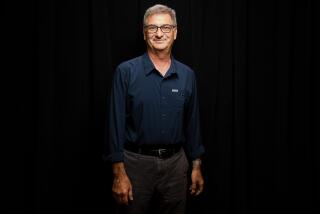Uplifting ‘Recycled, Re-Seen’ Celebrates the Clever Tinkerer
“Recycled, Re-seen: Folk Art From the Global Scrap Heap” presents so much wonderful stuff made from discarded bottle caps, pull tabs, worn tires, old plastic bags and disconnected telephone wires that you’ll be hard pressed not to believe the platitude about one man’s trash being another man’s treasure.
But what endows the nearly 700 handmade objects in this ambitious, user-friendly exhibition with the fascination of true treasures is the creative labor that went into their fabrication. At UCLA’s Fowler Museum of Cultural History, one man’s trash is simply another’s raw material. Human effort does the rest.
With the right skills, the proper vision and lots of patience, formerly worthless things are ingeniously transformed into multilayered artifacts. In the first gallery are one-of-a-kind quilts made of neckties, tobacco sacks, underwear labels and Aunt Jemima Cornmeal bags; they say as much about the need for warmth as they do about abstract patterning and an early American ethos in which thrift and resourcefulness are cast in moral terms and opposed to the vice of wastefulness.
Although such utilitarian virtues are often associated with a work ethic that leaves little room for unproductive play and the creation of useless decorations, Clarence and Grace Woolsey’s bottle-cap statuettes and Ray Cyrek’s pull-tab lawn ornaments suggest otherwise. In a country where the fine arts are often derided for being merely decorative, the work by these junk-artists signals a fairly sophisticated understanding of the compatibility between utility and ornamentation. Both, after all, improve one’s surroundings by bettering their look and feel.
The impulse to make beautiful things in an inhospitable environment takes concrete shape in a sampling of works by incarcerated convicts. Colorful purses made from canceled postage stamps and cigarette wrappers, along with handkerchiefs embroidered with threads from unraveled socks and a toy bear made of carefully folded and coffee-stained toilet paper demonstrate that people with lots of time on their hands will stopat nothing to express themselves.
One of the most engaging galleries contains dozens of idiosyncratic whistles, tambourines, rattles, flutes, fiddles, guitars, banjos, kettle drums and thumb pianos fabricated from tin pans, 55-gallon drums, bits of scrap metal, plastic buttons and cans once filled with beer, motor oil, sardines and gasoline. A monitor plays a videotape of a steel band from Trinidad, whose lively numbers range from calypso to European classics. Visitors are welcome to try their hand playing a double tenor steel drum, whose brassy clang echoes through the gallery.
The largest section of the show is dedicated to children’s toys. A few tiny roomfuls of dollhouse-size furniture (cut from tin cans) punctuate a big gallery filled with often wildly imaginative vehicles made from coat hangers, scrap wire, plastic bottles, “flip flop” sandals and cardboard boxes. The inventive use of materials in these little bicycles, race cars, helicopters, semis, spaceships and tanks perfectly complements a child’s imagination, which, more often than its adult counterpart, is enlisted to make the everyday world more fantastic than it usually is.
Among the most beautiful objects displayed are elaborately patterned bowls woven from colorful, plastic-covered strands of telephone wire. Among the most common are rubber sandals crafted from old car tires. Examples from Ecuador, Indonesia, Mexico, Morocco and Nigeria show just how global this style of recycling is.
All manner of cooking utensils and kerosene lanterns likewise reveal how people use their wits adapting what is at hand to serve new purposes. Much of the exhibition’s enchantment is due to the fact that all of its objects have one foot firmly planted in the specialized world of disposable, mass-produced conveniences and the other in that of make-do adaptation.
Organized by the Museum of International Folk Art in Santa Fe, N.M., “Recycled, Re-seen” celebrates the flip-side of consumerism. Here, a tinkerer’s talent to almost magically transform one thing into another is more valuable than a shopper’s ability to select the best product.
Think of all the works as inhabiting something like an afterlife, and you’ll have an idea of the exhibition’s redemptive, uplifting nature. As a whole, its hybrids neither condemn the world of consumerism in favor of traditional artisanry, nor presume that what’s sold in stores fully satisfies people’s needs. Instead, this playful show insists that what’s most exciting about modern life is the way it allows distinct, often contradictory realities to overlap. They form superimposed worlds with plenty of space for amazement.
*
* “Recycled, Re-seen: Folk Art From the Global Scrap Heap,” UCLA/Fowler Museum of Cultural History, 405 Hilgard Ave., Westwood, (310) 825-4361, through Jan. 2. Closed Mondays and Tuesdays. Admission free; parking $5.
More to Read
The biggest entertainment stories
Get our big stories about Hollywood, film, television, music, arts, culture and more right in your inbox as soon as they publish.
You may occasionally receive promotional content from the Los Angeles Times.










